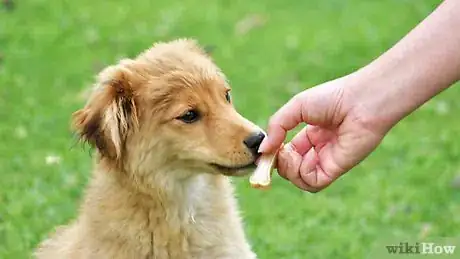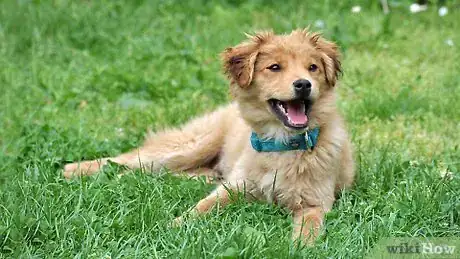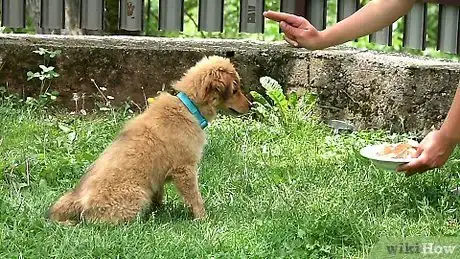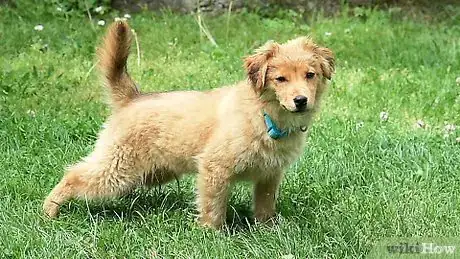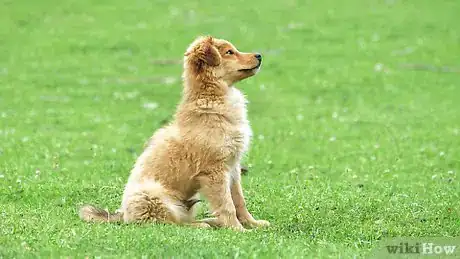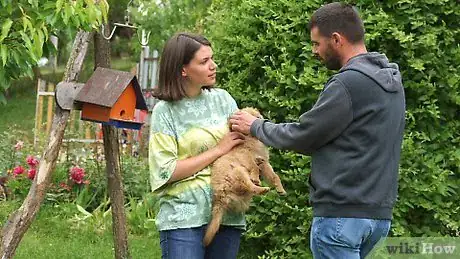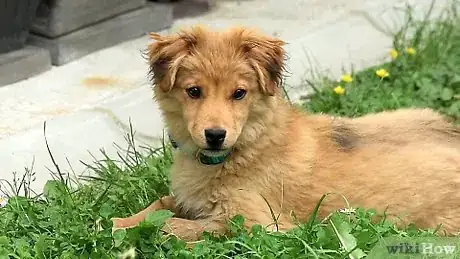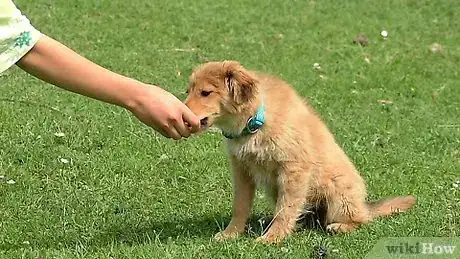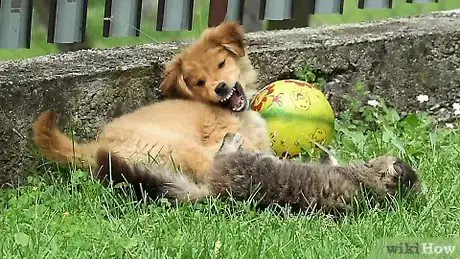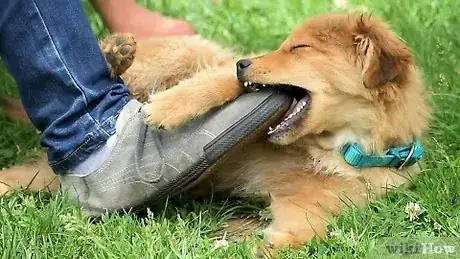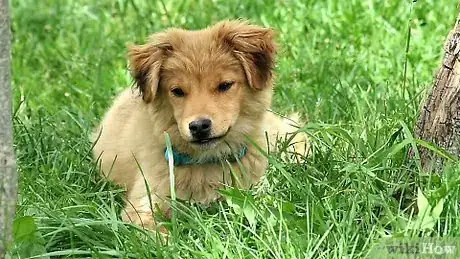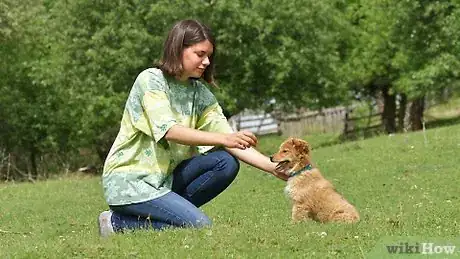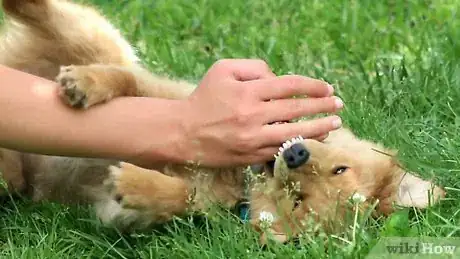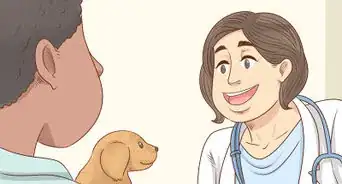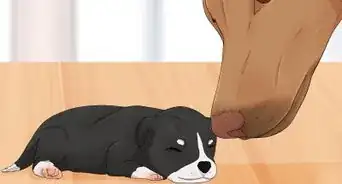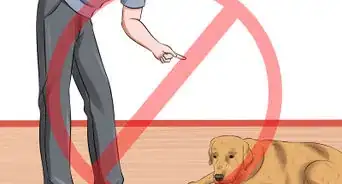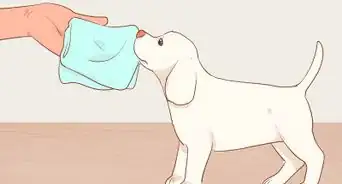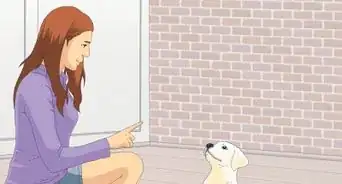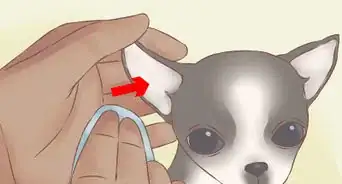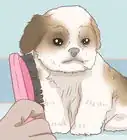This article was co-authored by David Levin. David Levin is the Owner of Citizen Hound, a professional dog walking business based in the San Francisco Bay Area. With over 9 years of professional dog walking and training experience, David's business has been voted the "Best Dog Walker SF" by Beast of the Bay for 2019, 2018, and 2017. Citizen Hound has also been ranked #1 Dog Walker by the SF Examiner and A-List in 2017, 2016, 2015. Citizen Hound prides themselves on their customer service, care, skill, and reputation.
There are 13 references cited in this article, which can be found at the bottom of the page.
wikiHow marks an article as reader-approved once it receives enough positive feedback. This article received 14 testimonials and 91% of readers who voted found it helpful, earning it our reader-approved status.
This article has been viewed 847,704 times.
Disciplining your puppy can feel a little overwhelming at times, but by focusing on a few simple strategies, you can get the best results. First, remember that repetition is much more important than force. Training takes time, but if you are patient and consistent, your puppy will start to figure things out. Second, try to act quickly; make sure that consequences happen within just a few seconds of any bad behavior to reinforce the connection.[1] Finally, remember to focus on good behavior at least as much as you do on bad behavior. Whenever your puppy does something right, make sure to give them a treat, pet them, or tell them they did a good job.
Things You Should Know
- Use positive rewards, like treats, toys, or praise to encourage productive behavior in your puppy.
- Avoid shouting at or physically punishing your puppy, since this will lead to behavior issues in the future.
- Consistency is key when it comes to enforcing rules and boundaries with your puppy.
- Withhold treats, use time outs, and ignore bad behavior to encourage your puppy to behave properly.
Steps
Encouraging Good Behavior
-
1Understand what motivates your puppy. Puppies are very social creatures. They want your attention and affection, whether it's simply a glance, talking to them in a fun, upbeat voice, giving them a special toy, rubbing and petting them, or giving a delicious treat. Pay attention to what your puppy best responds to. When you notice your puppy showing good behavior, immediately reward the action, so you puppy makes a positive association with the behavior.[2]
- Be consistent when you positively reinforce good behavior. Your puppy will quickly learn what behaviors you approve of and which won't get your much-wanted attention.[3]
-
2Create a routine. Puppies like knowing what to expect. Establish a daily routine with set times for meals, toileting, walks, and training sessions. This way, your puppy knows what is coming and what to expect.[4]
- A routine will help regulate your puppy regulate his behavior. For example, if it knows a walk comes after mealtime, your dog may save his energy for the outing.
Advertisement -
3Reassert your authority over your puppy. Your puppy will respect you more and respond to your discipline if you take clear control over him. To do this, give your commands in a stern tone of voice. You may also want to make your dog follow commands outside of training sessions. For example, make your puppy sit and wait briefly before setting down his food dish.
- Give your puppy time to fulfill your command. If it looks like your puppy isn't going to respond to your command, don't back down and give in. You need to show your puppy that it has to listen and obey your commands. Project your authority in a calm and assertive manner.[5]
-
4House train your puppy. Once you have a routine in place, make sure regular outings to eliminate are included. For example, try taking your puppy out to eliminate first thing in the morning, 15 to 20 minutes after meals, and consistently after naps or play periods. Your puppy will learn to understand when it's appropriate to eliminate, reducing chances of accidents.[6]
- You may want to start by crate training your puppy if you don't plan on taking it outside to eliminate.
-
5Train your puppy.[7] Teach your puppy a few basic commands (like "come," "sit," "stay"). This way, when you notice your puppy engaging in bad behavior, you can immediately redirect his attention. For example, if you notice your puppy running up and jumping on someone, you can quickly command it to "come." Your dog should stop jumping up on the person and come to you instead.[8]
- Teaching your puppy a few simple commands can also keep it safe. If your dog is about to do something dangerous, like run into traffic, you can command it to "sit" or "stay" so that you can reach him.
-
6Get help. If you've been patient with your puppy, but your dog still resists training or responding to your discipline, get help. You can ask your veterinarian to recommend a professional trainer or canine behaviorist.
- You might want to enroll your dog in an obedience training class taught by a professional. You'll learn helpful tips and your puppy will begin to understand what you expect from the training sessions that you also do at home.[9]
Reacting to Bad Behavior
-
1Start early and be consistent. You should start disciplining your puppy as soon as you bring it home. Puppies learn quickly and should be shown what behavior is unacceptable in your house. This also means that you must be consistent when responding to bad behavior. If not, your puppy will be confused, making it harder to prevent the bad behavior.[10]
- For example, say your puppy barks at the neighbors and you command it to stop. Then, it starts barking at the postal carrier, but you say nothing. Your puppy will be unsure about when it shouldn't bark, making it likely that your dog will bark whenever it feels like it.
-
2Use reward-based training for self-rewarding behaviors. Reward-based training uses discipline to help the puppy understand when something is a bad choice. Any type of reaction can be a reward in the dog's mind, so often the advice is to completely ignore bad behavior. However, if your dog is exhibiting behavior that's self-rewarding (for example, the dog enjoys chewing shoes) then this doesn't really work. That being the case, a short but sweet guiding command is appropriate. When it exhibits behavior you don't like, simply say "Not that" or similar words in a disapproving voice. The aim is not to scold him, but to guide him.
-
3Ignore bad behaviors that aren't self-rewarding. When your puppy tries to get your attention by barking, jumping up, or nipping at your fingers, it's best to ignore him. Consider what reward your puppy is trying to get when engaging in bad behavior in order to determine when to ignore him. If your dog is jumping up on you when you come home, it probably wants your attention. Withholding your attention sends the message that it needs to act differently to get your attention. Eventually, your puppy will learn that good behavior earns your attention and affection.[11]
- For example, if your puppy starts barking at you, turn your back to it and take away any attention. Your dog will learn that it gets nothing from you when it behaves poorly.
-
4Distract and redirect your puppy. Get your puppy's attention by making a loud noise. You might try clapping your hands and firmly saying "no" when you catch your puppy doing something undesirable, like chewing on your shoe or squatting to urinate on the carpet. The noise and disapproving tone will distract your puppy from the bad behavior. Redirect your puppy's attention on desirable behavior.[12]
- For example, if your dog was urinating inappropriately, pick up your puppy and immediately take it outside to the appropriate toilet spot.
-
5Use time-outs effectively. If your puppy is engaged in bad behavior, remove it from whatever is causing the behavior and place it in a different environment. You might put it in a quiet room in the house away from distractions or outside in the yard. Leave your dog in time-out for 10 to 30 seconds, then remove it and act as though nothing happened, if your dog has stopped the bad behavior (like barking). If your puppy hasn't stopped, wait until it does.[13]
-
6Stop your puppy from barking. Ignore your puppy's barking. If your dog's just trying to get your attention, it should soon stop. But, if it continues barking despite your inattention, figure out why your dog’ s barking and remove it. For example, if your dog is barking at the traffic out the window, pull the blinds. If the behavior continues, remove your dog to another room for a few minutes.[14]
- You can also try to quiet your dog by giving it something to chew like a rope toy.
-
7Keep your puppy from nipping. Puppies are naturally playful and have to learn limits when it comes to playing rough. As soon as your puppy nips, say "ouch" and yelp. Ignore your dog for up to 20 seconds after it lets go of your hand. This will teach your dog that you won't tolerate rough play.[15]
- Avoid pulling your hand away when your puppy nips. Your puppy will see this as part of the game and will continue to chase you.
-
8Avoid using physical punishment. Studies have shown that physically punishing your puppy (like hitting, kicking, growling, or staring down) actually increases aggression in your puppy.[16] You should never use physical punishment to correct undesirable puppy behavior.
- Physical punishment could injure your puppy and ruin your relationship.[17]
Expert Q&A
Did you know you can get expert answers for this article?
Unlock expert answers by supporting wikiHow
-
QuestionIs it OK to punish your puppy?
 David LevinDavid Levin is the Owner of Citizen Hound, a professional dog walking business based in the San Francisco Bay Area. With over 9 years of professional dog walking and training experience, David's business has been voted the "Best Dog Walker SF" by Beast of the Bay for 2019, 2018, and 2017. Citizen Hound has also been ranked #1 Dog Walker by the SF Examiner and A-List in 2017, 2016, 2015. Citizen Hound prides themselves on their customer service, care, skill, and reputation.
David LevinDavid Levin is the Owner of Citizen Hound, a professional dog walking business based in the San Francisco Bay Area. With over 9 years of professional dog walking and training experience, David's business has been voted the "Best Dog Walker SF" by Beast of the Bay for 2019, 2018, and 2017. Citizen Hound has also been ranked #1 Dog Walker by the SF Examiner and A-List in 2017, 2016, 2015. Citizen Hound prides themselves on their customer service, care, skill, and reputation.
Professional Dog Trainer
-
QuestionWhat should I do if my puppy won't eat any food?
 Boo-BooCommunity AnswerTake him to the vet. It could be something serious, or as simple as pain from teething. Either way, the vet will know what to do and how to best advise you.
Boo-BooCommunity AnswerTake him to the vet. It could be something serious, or as simple as pain from teething. Either way, the vet will know what to do and how to best advise you. -
QuestionShould I ever punish my puppies by not giving them a meal?
 Community AnswerNo. Use a commanding voice, ignore and redirect. Taking away a meal is akin to abuse.
Community AnswerNo. Use a commanding voice, ignore and redirect. Taking away a meal is akin to abuse.
wikiHow Video: How to Discipline Your Puppy
References
- ↑ David Levin. Dog Training Coach. Expert Interview. 19 December 2019.
- ↑ David Levin. Dog Training Coach. Expert Interview. 19 December 2019.
- ↑ http://www.humanesociety.org/animals/dogs/tips/dog_training_positive_reinforcement.html?referrer=https://www.google.com/
- ↑ https://www.cesarsway.com/dog-care/puppies/how-to-create-a-puppy-schedule
- ↑ https://www.cesarsway.com/dog-psychology/pack-leader/how-to-be-calm-and-assertive
- ↑ http://www.humanesociety.org/animals/dogs/tips/housetraining_puppies.html
- ↑ David Levin. Dog Training Coach. Expert Interview. 19 December 2019.
- ↑ https://www.aspca.org/pet-care/virtual-pet-behaviorist/dog-behavior/training-your-dog
- ↑ https://apdt.com/pet-owners/choosing-a-trainer/
- ↑ http://www.petplace.com/article/dogs/keeping-your-dog-healthy/puppy-care/how-to-prevent-common-puppy-behavior-problems
- ↑ http://www.petplace.com/article/dogs/keeping-your-dog-healthy/puppy-care/how-to-prevent-common-puppy-behavior-problems
- ↑ http://www.humanesociety.org/animals/dogs/tips/puppy_nipping_rough_play.html
- ↑ https://www.aspca.org/pet-care/virtual-pet-behaviorist/dog-behavior/using-time-outs-effectively
- ↑ http://pets.webmd.com/features/breaking-bad-habits
- ↑ https://www.cesarsway.com/dog-behavior/biting/nipping-nipping-in-the-bud
- ↑ https://www.psychologytoday.com/blog/canine-corner/201205/is-punishment-effective-way-change-the-behavior-dogs
- ↑ http://www.petplace.com/article/dogs/keeping-your-dog-healthy/puppy-care/how-to-prevent-common-puppy-behavior-problems
About This Article
To discipline your puppy, try a consistent time-out routine. For example, if your puppy barks at your neighbor, place your puppy in a quiet room for 10-30 seconds, then allow it to return as if nothing has happened. If the bad behavior continues, remove it again until it stops. Similarly, if your puppy nips, say “ouch” and ignore it for 20 seconds. Consistency also works for house training. Take your puppy our first thing in the morning, 15-20 minutes after meals, and after naps and playtime. Your puppy will soon learn when it’s appropriate to eliminate. To learn more about how to encourage good behavior from our Veterinarian co-author, keep reading the article!

